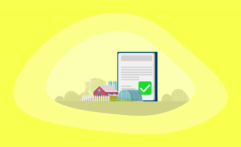9 Best Carbon Offsetting Apps (Complete 2024 List)
Impactful Ninja is reader-supported. When you buy through links on our site, we may earn an affiliate commission.
Learn more
Learn more
.
Hey fellow impactful ninja ? You may have noticed that Impactful Ninja is all about providing helpful information to make a positive impact on the world and society. And that we love to link back to where we found all the information for each of our posts. Most of these links are informational-based for you to check out their primary sources with one click. But some of these links are so-called "affiliate links" to products that we recommend. First and foremost, because we believe that they add value to you. For example, when we wrote a post about the environmental impact of long showers, we came across an EPA recommendation to use WaterSense showerheads. So we linked to where you can find them. Or, for many of our posts, we also link to our favorite books on that topic so that you can get a much more holistic overview than one single blog post could provide. And when there is an affiliate program for these products, we sign up for it. For example, as Amazon Associates, we earn from qualifying purchases. First, and most importantly, we still only recommend products that we believe add value for you. When you buy something through one of our affiliate links, we may earn a small commission - but at no additional costs to you. And when you buy something through a link that is not an affiliate link, we won’t receive any commission but we’ll still be happy to have helped you. When we find products that we believe add value to you and the seller has an affiliate program, we sign up for it. When you buy something through one of our affiliate links, we may earn a small commission (at no extra costs to you). And at this point in time, all money is reinvested in sharing the most helpful content with you. This includes all operating costs for running this site and the content creation itself. You may have noticed by the way Impactful Ninja is operated that money is not the driving factor behind it. It is a passion project of mine and I love to share helpful information with you to make a positive impact on the world and society. However, it's a project in that I invest a lot of time and also quite some money. Eventually, my dream is to one day turn this passion project into my full-time job and provide even more helpful information. But that's still a long time to go. Stay impactful,Affiliate Disclosure
Why do we add these product links?
What do these affiliate links mean for you?
What do these affiliate links mean for us?
What does this mean for me personally?
![]()
With the global rise of smartphones and the advancement of the technology industry, the mobile app development market could be worth over $350 billion by 2030. When partnered with apps, carbon offsets can reach a greater number of people and have a larger impact. So, we had to ask: What are the best carbon-offsetting apps?
The best organizations for carbon offset apps in terms of overall impact are Klima, Commons, and Karbon-X, which offer a range of third-party verified carbon offsets. Capture and Aerial have also developed offset apps that offset your travel carbon footprint.
Keep reading to learn more about the best carbon-offsetting apps, how these carbon offset projects work, what their respective offsetting costs are, and what your best way would be to offset your carbon emissions. At the end of the article, we’ll also share with you what the biggest carbon offsetting limitations are and why reducing your carbon footprint is more effective than offsetting it.
Here’s What All the Best Carbon Offsetting Apps Have in Common
Carbon offsets are reductions in carbon emissions that are used to compensate for carbon emissions occurring elsewhere. They are measured in tons of CO2 equivalents and are bought and sold through international brokers, online retailers, and trading platforms on what is known as the global carbon offset market.
“Carbon Offset: a way for a company or person to reduce the level of carbon dioxide for which they are responsible by paying money to a company that works to reduce the total amount produced in the world, for example by planting trees”
Oxford Dictionary
When you purchase carbon offsets, it’s important that they actually make a difference in total carbon emissions. To achieve that, the following are key criteria:
- Carbon offset projects have to be effective (different projects have different effectiveness rates)
- Carbon offset projects have to be additional
- Carbon offset projects have to be permanent
- The claims from carbon offset projects have to be verifiable
(For a full overview, check out our guide on how to choose carbon offset projects that actually make a difference.)
These Are the Best Carbon Offsetting Apps in 2024
Below are our favorite carbon offsetting apps (you can click on their link to directly jump to their section in this article):
| Carbon-Offsetting Apps | Quick Facts |
| Klima | About: Karbon-X has partnered with Heimdal, Plexus Technology Corp, Silvicultural Systems, and SCB Environmental Markets to offer carbon offset projects involving solar power, wind power, reforestation, direct CO2 capture, and waste gas flaring in their app. Costs: $13 per 1,000kg of CO2 |
| Commons | About: The Commons app calculates the carbon equivalent of each purchase to calculate your carbon footprint. Their carbon offset portfolio includes bio oil + injection, soil carbon sequestration, forestry, and kelp forestry carbon offset projects. Costs: $25 per 1,000kg of CO2 |
| Karbon-X | About: Karbon-X has developed an app that targets 5 climate offset strategies: air, earth, energy, innovation, and water. Their carbon offset projects include solar power, wind power, reforestation, direct CO2 capture, and waste gas flaring. Costs: $22-$29 per 1,000kg of CO2 |
| Capture | About: Capture has developed a carbon offset app that tracks, reduces, and removes carbon emissions by using GPS information to predict emissions from daily modes of travel. You can purchase verified tree planting or carbon reduction carbon offsets. Costs: $13 per 1,000kg of CO2 |
| Aerial | About: Aerial has developed an app that calculates your travel emissions from past flights and rideshares and allows you to offset those emissions via verified offset projects. They support projects including carbon removal in California, forest conservation in Vermont, and REDD+ in Cambodia. Costs: Costs are determined after downloading the app |
| Treeapp | About: With Treeapp’s business carbon offset plans, you can offset emissions from your team or company by supporting global reforestation projects in Wales, Haiti, Brazil, Kenya, Madagascar, and Indonesia. Costs: $8 per 1,000kg of CO2 |
| LiveGreen | About: The LiveGreen app automatically tracks your emissions from car trips and flights and calculates emissions from your meals, utilities, and purchases. Based on your emissions, you can purchase carbon offsets that support reforestation and carbon removal projects globally. Costs: Costs after determined after initial contact |
| Decarbon | About: Decarbon has partnered with Patch, a third-party organization that connects companies to vetted climate action projects, to develop a carbon offsetting app. Carbon offsets are available as a single purchase, where you can choose the specific project to contribute to, or as a subscription, where Decarbon selects the projects for you. Costs: Costs vary depending on the carbon offset project |
| Goodside | About: The Goodside app is currently in the testing phase. Goodside has partnered with Patch to offer improved forest management, soil carbon sequestration, bio-oil, concrete mineralization, REDD+, gas capture, and biochar carbon offset projects. Costs: Costs vary depending on the carbon offset project |
Klima: Your Holistic Climate Action Strategy
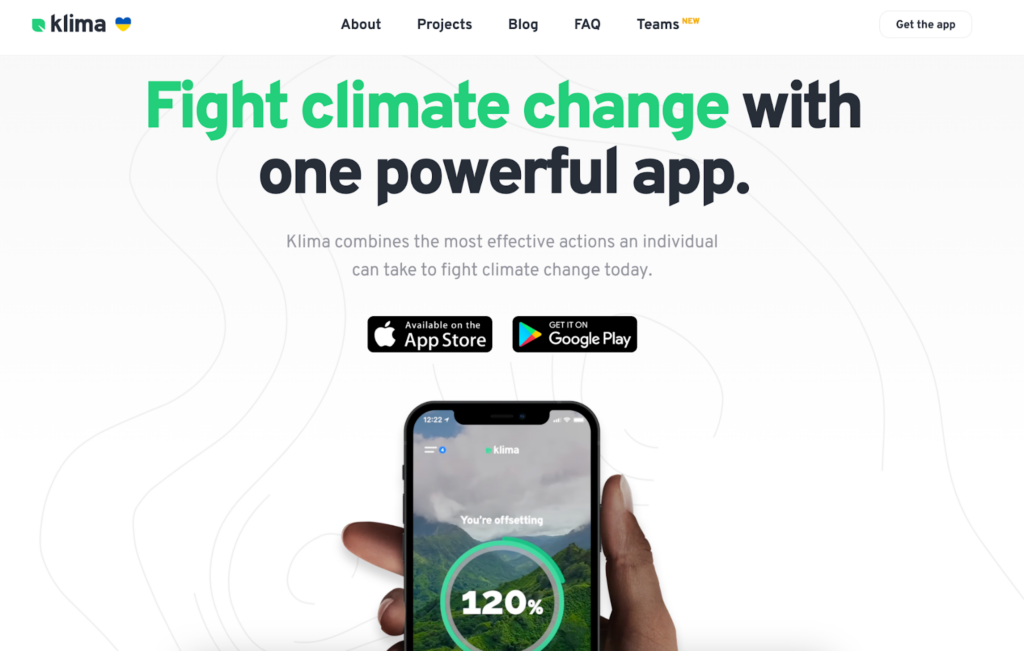
Klima was founded in 2019 by friends Markus Gilles, Jonas Brandau, and Andreas Pursian-Ehrlich to help answer the question “I am just one person – what can I even do?”. Today, you can fund nature, tech, and social climate solutions via their carbon offsetting app.
“Fight climate change with one powerful app.”
Klima
Project overview: Klima has developed an app that calculates your carbon footprint, offsets the emissions you can’t avoid, and helps you reduce your emissions. Klima supports carbon offset projects including planting trees in Panama and Tanzania, solar power in Mauritania, South Africa, and Vietnam, and clean cookstoves in Ghana.
Carbon offset effectiveness: Klima’s offset projects are verified through the Verified Carbon Standard or Gold Standard. Each project also adheres to at least 4 of the United Nations Sustainable Development Goals (UN SDGS).
Carbon offset costs: The Klima app is free to download and use. Offset projects cost approximately $13 per 1,000kg of CO2.
How to get your carbon offsets: You can download Klima’s app in either the App Store or Google Play to get your carbon offsets.
Commons: Shaping a Sustainable World
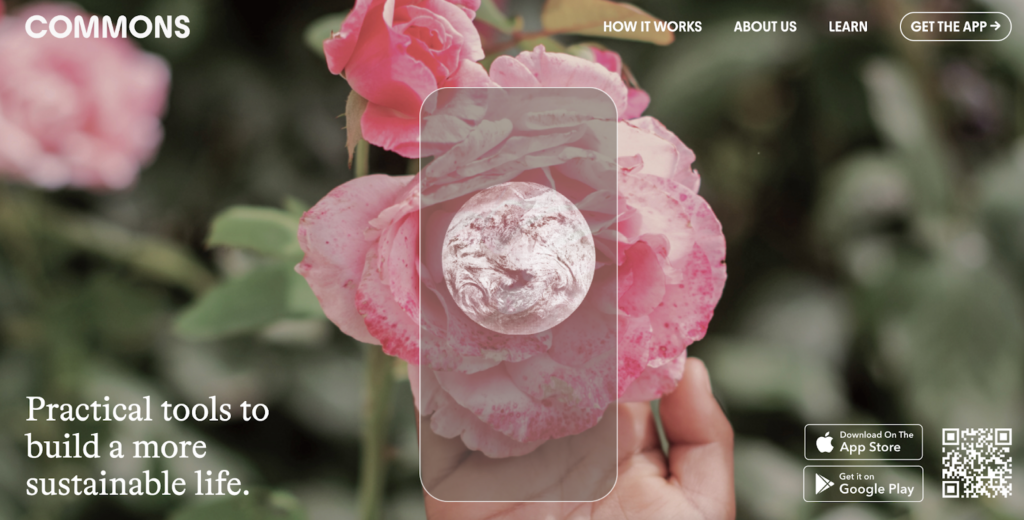
Commons was founded in 2018 by Sanchali Seth Pal as a tool to help reverse the climate crisis. Today, they have developed a vetted portfolio of carbon offset projects aimed at reducing and removing carbon and prioritizing innovation, scalability, and environmental justice.
“Awaken your carbon consciousness.”
Commons
Project overview: The Commons app allows you to track, act upon, and offset your carbon emissions. When you sync your spending to the app, it calculates the carbon equivalent of each purchase to calculate your carbon footprint. The current Commons offset portfolio includes bio oil + injection, soil carbon sequestration, forestry, and open ocean kelp forestry carbon offset projects.
Carbon offset effectiveness: Commons has partnered with Nori, Running Tide, Pachama, NCX, Grassroots Carbon, and Charm Industrial to provide vetted carbon offset projects. Pachama is also included in our Best REDD+ Carbon Offsets article.
Carbon offset costs: Commons’ offset projects cost approximately $25 per 1,000kg of CO2.
How to get your carbon offsets: You can download the Commons app in either the App Store or Google Play to get your carbon offsets.
Karbon-X: A Carbon Offset Subscription App

Karbon-X was founded by Chad Clovis to be an accessible and empowering way to fight climate change. Today, their app supports CO2-reducing projects across the globe that protect our oceans, air, and forests.
“Small actions make big change.”
Karbon-X
Project overview: Karbon-X has developed an app that targets 5 climate offset strategies: air, earth, energy, innovation, and water. Their carbon offset projects involve solar power, wind power, reforestation, direct CO2 capture, and waste gas flaring. The app is currently available for download on the App Store, Google Play, or as a web application.
Carbon offset effectiveness: Karbon-X has partnered with Heimdal, Plexus Technology Corp, Silvicultural Systems, and SCB Environmental Markets to provide carbon offset projects verified by either the Verified Carbon Standard or the Gold Standard.
Carbon offset costs: Karbon-X’s basic subscription plan ranges from $22-$29 per 1,000kg of CO2 offset per employee per year. Their business subscription plan ranges from $22-$26 per 1,000kg of CO2 offset per employee per year.
How to get your carbon offsets: You can download Karbon-X’s app on the App Store, Google Play, or the web to get your carbon offsets.
Capture: Encouraging People to Adapt Climate-Friendly Lifestyles
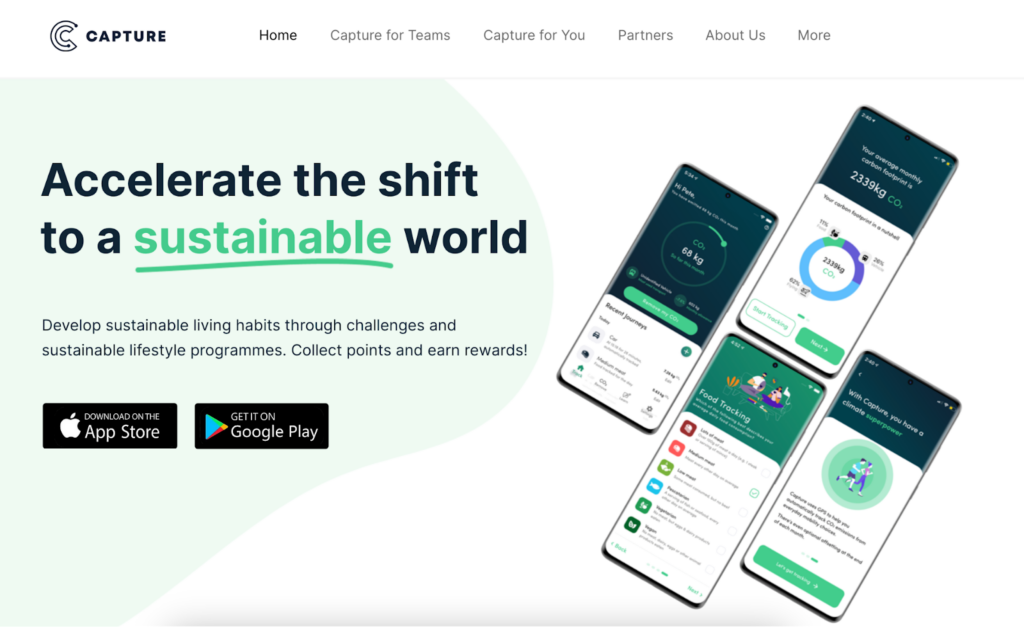
Capture was founded in 2019 by Aziz and Josie as a tool to empower people around the world to live more sustainable lives. Today, they offer climate solutions for businesses and individuals looking to reduce their carbon footprints.
“Accelerate the shift to a sustainable world”
Capture
Project overview: Capture has developed a carbon offset app that tracks, reduces, and removes carbon emissions by using GPS information to predict emissions from daily modes of travel. You can then either automatically offset or offset emissions as you go by choosing from verified tree planting or carbon reduction carbon offsets.
Carbon offset effectiveness: Capture’s carbon offset projects are selected from leading standards including the Gold Standard, American Carbon Registry, and Carbon Action Reserve.
Carbon offset costs: The Capture app is free to download and use. Offset projects cost approximately $13 per 1,000kg of CO2 offset.
How to get your carbon offsets: You can download Capture’s app in either the App Store or Google Play to get your carbon offsets.
Aerial: Offset Your Travel Footprint

Aerial was founded in 2020 by Andreas Homer, Ari Sawyers, and Ebby Amir as a company focused on creating innovative ways to put climate action in everyone’s hands. Today, they work with verified, global environmental efforts to remove carbon emissions via carbon offsets.
“Bringing Our World Back to Life”
Aerial
Project overview: Aerial has developed an app that calculates your travel emissions from past flights and rideshares and allows you to offset those emissions via verified offset projects. They support projects including carbon removal in California, forest conservation in Vermont, and REDD+ in Cambodia.
Carbon offset effectiveness: Aerial’s carbon offset projects are verified according to either the Verified Carbon Standard, American Carbon Registry, or Climate Action Reserve. They also adhere to the UN SDGs.
Carbon offset costs: Costs are determined after downloading the app.
How to get your carbon offsets: You can download Aerial’s app in either the App Store or Google Play to get your carbon offsets.
Treeapp: A Global Reforestation Initiative
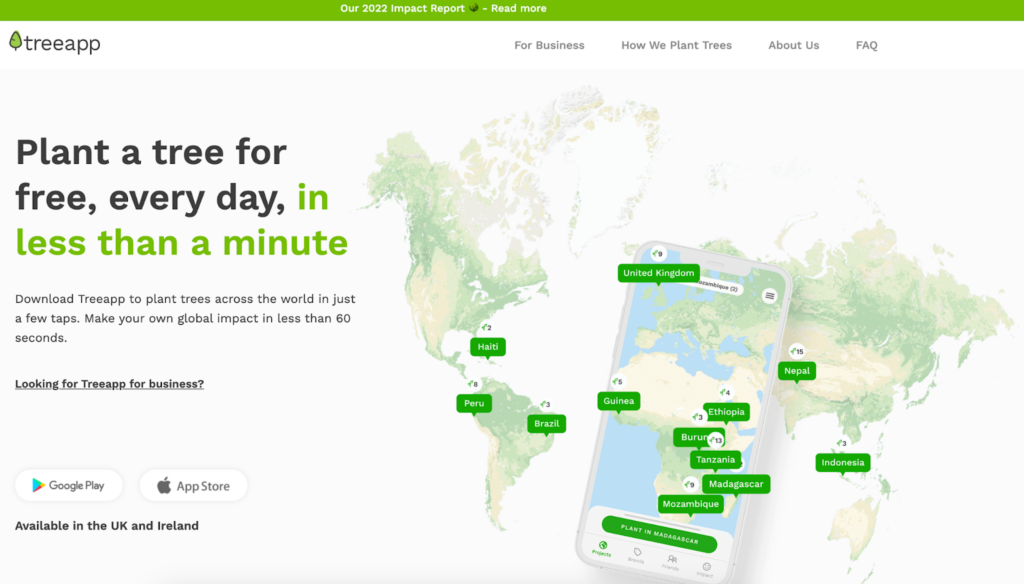
Treeapp was founded in 2019 by Godefroy Harito and Jules Buker as a tree-planting organization aimed at reducing deforestation. Today, they are one of the leading tree planting organizations in the United Kingdom and have planted over 2 million trees. In the future, they aim to expand internationally and plant 1 million trees per day.
“Plant a tree for free, every day, in less than a minute”
Treeapp
Project overview: Treeapp offers 2 types of programs, one which allows users to plant one tree everyday for free, and another which helps businesses offset their carbon footprint. With their business carbon offset plans, you can offset emissions from your team or company by supporting global reforestation projects. Treeapp’s global portfolio of projects includes reforestation projects in Wales, Haiti, Brazil, Kenya, Madagascar, and Indonesia.
Carbon offset effectiveness: Treeapp’s reforestation projects adhere to multiple UN SDGs. Treeapp also tracks its reforestation efforts on Restor, an open-source platform for restoration and conservation sites across the globe.
Carbon offset costs: The Treeapp app is free to download and use. Their business carbon offset plans cost roughly $5, $10, or $20 per employee per month, which works out to roughly $8 per 1,000kg of CO2. Individuals can also plant trees for $1 for every tree planted.
How to get your carbon offsets: You can download Treeapp’s app in either the App Store or Google Play to get your carbon offsets.
LiveGreen: Reforestation-Supported Carbon Offsets

LiveGreen was founded in 2019 by Brian de Souza to take action against the current climate crisis. Today, they offer carbon offset solutions for individuals and businesses, and they have helped offset over 13 million pounds of CO2 to date.
“Make your company greener, from the inside out.”
LiveGreen
Project overview: The LiveGreen app helps you to understand, reduce, and offset your carbon footprint by automatically tracking your emissions from car trips and flights and calculating emissions from your meals, utilities, and purchases. Based on your emissions, your purchases then fund reforestation and carbon removal projects globally. Examples of projects include reforestation in Haiti, Madagascar, Nepal, and the US.
Carbon offset effectiveness: LiveGreen’s planting partners include the National Forest Foundation and Eden Reforestation Projects, which are included in our Best Carbon Offsets for Reforestation article. Their projects also adhere to one or more of the United Nations Sustainable Development Goals (UN SDGS).
Carbon offset costs: Costs are determined after initial contact.
How to get your carbon offsets: You can download the LiveGreen app in the App Store to get your carbon offsets.
Decarbon: An Open-Source Carbon Budgeting App

Decarbon was founded in 2020 by Kyle Graycar because he desired to understand what his impact on climate change was and what he could do about it. Today, they are on a mission to create harmony between humans and nature via consumer empowerment.
“We give a damn”
Decarbon
Project overview: Decarbon has partnered with Patch, a third-party organization that connects companies to vetted climate action projects, to develop a carbon offsetting app. Carbon offsets are available as a single purchase, where you can choose the specific project to contribute to, or as a subscription, where Decarbon selects the projects for you. The app is currently available for download on the App Store, Google Play, or as a web application.
Carbon offset effectiveness: Decarbon has partnered with Patch, whose carbon offset projects are verified according to leading standards including the Verified Carbon Standard and American Carbon Registry.
Carbon offset costs: The Decarbon app is free to download and use. Carbon offset costs vary depending on the project.
How to get your carbon offsets: You can download Decarbon’s app on the App Store, Google Play, or the web to get your carbon offsets.
Goodside: A Real-Time Carbon Footprint App
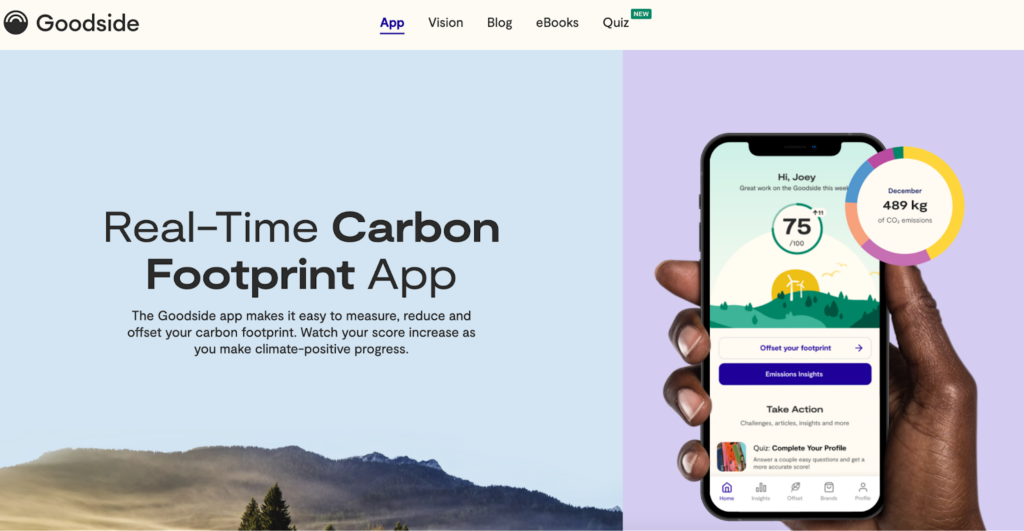
Goodside was founded in 2020 by Jaeson Cardiff and Victoria Beretta as a way to make sustainability accessible to everyone. Today, their carbon footprint tracker helps people take the steps to become net zero and positively impact the planet.
“Bringing our World Back to Life”
The World Wide Fund for Nature
Project overview: The Goodside app is currently in the testing phase and requires an invite to participate. Upon implementation, it will allow you to measure, reduce, and offset your carbon footprint. Goodside has partnered with Patch, a third-party organization that connects companies to vetted climate action projects. These projects can include improved forest management, soil carbon sequestration, bio-oil, concrete mineralization, REDD+, gas capture, and biochar.
Carbon offset effectiveness: Goodside has partnered with Patch, whose carbon offset projects are verified according to leading standards including the Verified Carbon Standard and American Carbon Registry.
Carbon offset costs: The Goodside app will be free to download and use. Carbon offset costs will vary depending on the project.
How to get your carbon offsets: The Goodside app is currently in the testing phase and requires an invite to participate. In the future, it will be available on both the App Store and Google Play.
How to Choose Carbon Offset Projects Actually Make a Difference
The following information is a summary for you based on our full guide: “How to Buy Carbon Offsets That Actually Make a Difference”
Purchase carbon offset projects with high effectiveness rates. The offset programs in order of most to least effective are:
- Direct CO2 removal: Machines remove CO2 directly from the air. Effective at reducing emissions in the short and long-term because they are additional and permanent.
- Renewable energy: Investing in projects that build and maintain renewable energy sites globally. There is no additionality because renewables are becoming a greater share of our energy mix, with or without the help of offsets.
- Energy efficiency improvements: The creation of products or systems that use less energy than conventional systems to perform the same task. However, if products are replaced too quickly, the amount of CO2 required to produce the new product would exceed the amount of CO2 saved with the new product.
- Carbon sequestration: The long-term storage of carbon via forestry practices. Not an effective way to reduce emissions in the long term because there is no guaranteed permanence.
If – and only if – they are both additional and permanent, carbon offsets can help reduce your overall GHG emissions to balance off your personal carbon footprint to fight climate change – at least in the short term. But they can be much more effective if they meet certain key criteria and project standards.
Here are key criteria to look for in a carbon offset program:
- A clearly defined protocol that determines which types of projects are eligible and how emission reductions will be measured
- Independent third-party verification of compliance with the protocol
- Registration of offsets in an offset registry, which tracks each credit with a unique serial number to ensure it is only used once
- Transparency in project implementation and reporting
If used correctly, carbon offsets can provide environmental, economic, and social benefits that go beyond reducing carbon emissions. They have the potential to instigate meaningful environmental change and begin to reverse some of the effects of climate change.
Carbon offset project standards assure transparency and quality in the creation, quantification, and verification of offset projects. This way you can ensure that the project is actually reducing CO2 emissions. The following are recognized carbon offset standards:
- Verified Carbon Standard (VCS): Considered the world’s leading voluntary GHG program, with 1,700+ projects having removed 630+ million tons of CO2 from the atmosphere. Examples of projects include hydropower in Turkey, forest conservation in Peru, and landfill gas capture in China.
- Gold Standard: A certification that seeks to maximize every dollar of climate and development funding. It has issued 134 million carbon credits from 1,700+ projects based in more than 80 different countries. Examples of projects include solar power in India, efficient cooking and heating in China, and wind power in Indonesia.
- Climate Action Reserve (CAR): The premier carbon offset registry for the North American carbon market having issued over 150 million offset credits since its inception in 2001. Examples of projects include landfill gas capture in South Carolina and forest management in California.
- American Carbon Registry (ACR): The first private voluntary GHG registry in the world. Examples of projects include ozone-depleting substances in Arkansas and methane capture from mines in Kentucky.
Choosing carbon offset projects from any of the above project standard registries helps ensure that your project is verified and that it actually reduces CO2 emissions.
What Are the Biggest Carbon Offsetting Limitations
In fact, there are 9 main carbon offsetting limitations that can make the current voluntary carbon market controversial and lead to confusion, inconsistencies, and a general distrust of the system. Have a look at the quick summary table below.
| Carbon Offsetting Limitation | Quick Facts |
| #1: You don’t reduce your own carbon footprint | When you purchase a carbon offset, you are paying someone else to cut their emissions so you don’t have to cut your own emissions. |
| #2: Carbon offsets do not work at the core issue of reducing CO2 emissions | Global warming is still occurring at an accelerated rate because offsetting CO2 emissions does not cut CO2 emissions at the source, it only mitigates emissions. |
| #3: Carbon offsetting only reduces CO2 if the projects are additional and permanent | If carbon offset projects are not additional and permanent, they can make climate change worse because they are not offsetting any carbon. |
| #4: “Poorer” countries are paid to offset carbon while the “rich” countries continue to emit | The richest of the world emit the majority of the world’s carbon. Offsets are just licenses to pollute with the benefit of aiding those in developing countries. |
| #5: Different projects have different effectiveness rates | The varying levels of effectiveness of carbon offset programs make it difficult to choose one that actually reduces emissions. The most effective offset programs are renewable energy programs, followed by energy efficiency improvements, carbon sequestration, and aviation offset programs. |
| #6: CO2 offsets are only realized at the end of project durations | If a carbon offset program is not carried out until the end, then we cannot reap the program’s benefits. For example, planting trees is a common offset program that is only effective if those planted trees are protected during their life span for the carbon benefits to be realized. |
| #7: There are not enough offsets for all CO2 emissions | We emit far more CO2 than we can offset because of carbon sink (e.g., atmosphere, forests, soil, ocean) limitations. |
| #8: Not all offset projects get realized | Of the credits for 1 billion tons of CO2 listed on registries, only about 300-400 million tons of CO2 offsets actually get realized. |
| #9: Carbon offsetting projects are often used as greenwashing | Investing in non-verified credits, not prioritizing in-house emissions reductions, and double-counting carbon credits are methods of greenwashing. Also, companies may advertise a specific program, but it may be just for public attention instead of actually reducing emissions. |
You can check out the full article here: “What Are the Biggest Carbon Offsetting Limitations? (All 9 Explained)”
Why Reducing Your Carbon Footprint Is More Effective Than Offsetting It
The main argument against carbon offsets is that they don’t really reduce overall emissions. Instead of substituting offsetting carbon emissions, we should instead cut the emissions directly at the source. Basically, if we stop emissions from getting into the atmosphere in the first place, we won’t have to worry about offsetting. But have we done this? Have we cut emissions directly at the source? The data says no.
The COVID-19 pandemic triggered the largest decrease in energy-related carbon emissions since World War II, a decrease of 2 billion tons. However, emissions rebounded quickly at the end of 2020, with levels in December ending 60 million tons higher than those in December 2019. This indicates that the earth is still warming at an accelerated rate, and not enough is being done to implement clean energy practices.
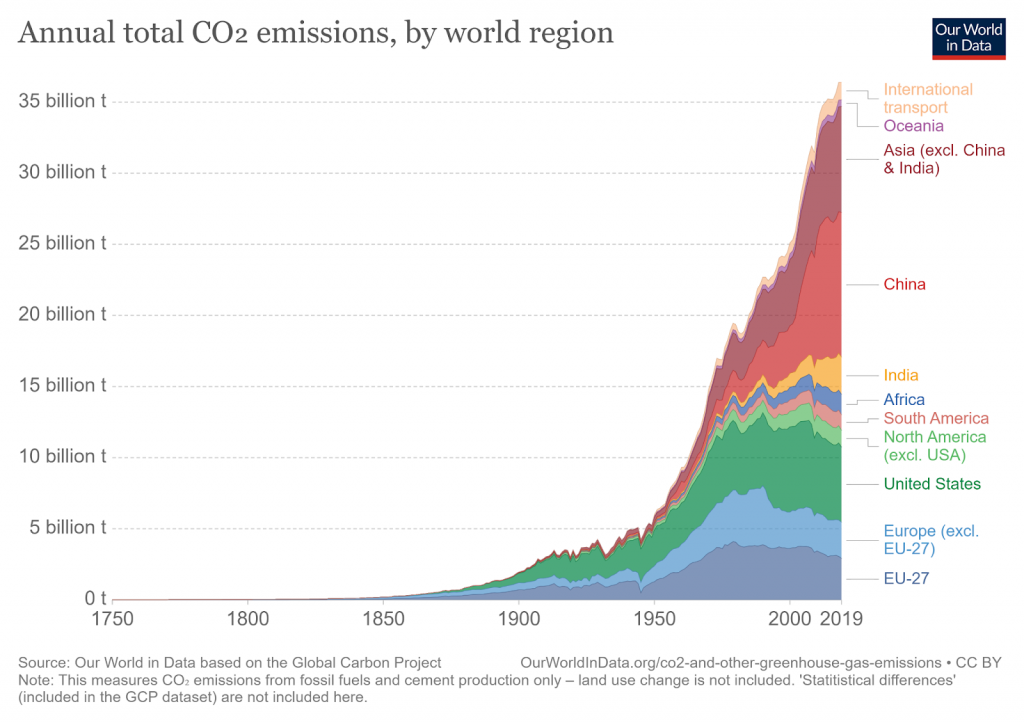
When you buy a carbon offset, you are paying someone else to cut their emissions so you don’t have to cut your own emissions. This is why offsetting alone will not be enough to reduce global carbon emissions.
Carbon offsets are a good place to start if you want to get into the carbon-emission reduction game, but to be effective in the long term, we must not rely on them solely. Cutting emissions from the source and then offsetting the remainder is the best way to reduce our carbon footprint and provide the highest environmental benefits. If we fail to cut emissions first, we will fill up our carbon sinks and render them unusable. Preventing carbon emissions rather than reacting once they are already emitted is the best way to reduce overall emissions.
Carbon offsets reduce GHG emissions from coal, oil, and natural gas. Reducing your consumption of these, in turn, reduces your carbon footprint, which has huge impacts on environmental, economic, and public health. A reduced carbon footprint due to lower GHG emissions can mitigate the effects of climate change, improve public health, boost the economy, and maintain plant and animal diversity.
- Climate change: Reducing your carbon footprint plays a role in mitigating the side effects of global climate change. The more we reduce the amount of GHG emissions, the more we slow the rate of temperature rise, sea-level rise, ice melting, and ocean acidification.
- Public health: Reducing GHG emissions lessens the likelihood and severity of extreme weather events, improves air and water quality, maintains biodiversity, and supports a healthy food supply.
- Economics: Reducing GHG boosts the economy, especially when it becomes economically rewarding to innovate solutions that help protect our planet, fight climate change, and are based on clean energy.
- Plant and animal diversity: Protecting biodiversity protects human health because many plants and animals are used in modern medicines
Carbon offsets have the potential to instigate meaningful environmental change, but to make the greatest impact we must understand both their benefits AND drawbacks.
You can find out all about it in our article “Can You Really Offset Your Carbon Footprint? Here Are the Facts”
Final Thoughts
Klima, Commons, Karbon-X, Capture, Aerial, Treeapp, LiveGreen, Decarbon, and Goodside have the best carbon offset apps for individuals and organizations looking to reduce their carbon footprint. They are third-party verified, use the leading carbon offset standards, and adhere to one or more of the UN’s Sustainable Development Goals.
But for all of the good carbon offsets can instigate, they should not be seen as the only solution to climate change. They are effective at reducing CO2 in the short term, but in the long term, they fail to reduce CO2 enough. When used in conjunction with direct CO2 reduction measures, carbon offsetting can be much more effective. We should reduce our own carbon footprint as much as possible first, and only then choose the most effective carbon offset apps.
Stay impactful,

Sources
- GlobeNewsWire: Mobile App Development Market Worth USD 366.34 Billion by 2030 Growing at a 23.80% CAGR
- U.S. Environmental Protection Agency: Offsets and RECs -What’s the Difference?
- Britannica: Carbon Offset
- David Suzuki Foundation: Are carbon offsets the answer to climate-altering flights?
- Impactful Ninja: How to Buy Carbon Offsets That Actually Make a Difference (Complete Guide)
- Klima: Homepage
- Klima: Projects
- App Store: Klima
- Google Play: Klima
- Verified Carbon Standard: Homepage
- Gold Standard: Homepage
- United Nations Department of Economic and Social Affairs: The 17 Goals
- Commons: Homepage
- Commons: Projects in the Commons Offset Portfolio
- Nori: Homepage
- Running Tide: Homepage
- Pachama: Homepage
- NCX: Homepage
- Grassroots Carbon: Homepage
- Charm Industrial: Homepage
- Impactful Ninja: 9 Best REDD+ Carbon Offsets
- App Store: Commons
- Google Play: Commons
- Karbon-X: Homepage
- Heimdal: Homepage
- Plexus Technology Corp: Homepage
- SCB Environmental Markets: Homepage
- App Store: Karbon-X
- Google Play: Karbon-X
- Karbon-X: Portal
- Capture: Homepage
- Capture: Carbon Footprint Tracker and Sustainability App
- Capture: About Capture
- The American Carbon Registry: Homepage
- App Store: Capture
- Google Play: Capture
- Aerial: Homepage
- Aerial: Offset Your Carbon Footprint
- App Store: Aerial
- Google Play: Aerial
- Climate Action Reserve
- Treeapp: Homepage
- Restor: Treeapp
- Treeapp: Treeapp for Business
- Treeapp: Tree Planting
- App Store: Treapp
- Google Play: Treeapp
- Restor: Homepage
- LiveGreen: Homepage
- LiveGreen: Track your emissions and learn how to reduce them
- LiveGreen: About
- The National Forest Foundation: Homepage
- Eden Reforestation Projects: Homepage
- Impactful Ninja: Best Carbon Offsets for Reforestation
- Gmail: Contact
- App Store: LiveGreen
- Decarbon: Homepage
- Decarbon: Decarbon’s elevator pitch
- Patch: About
- Patch: How it Works
- App Store: Decarbon
- Google Play: Decarbon
- Decarbon: Decarbon App
- Goodside: Homepage
- Goodside: FAQs
- Impactful Ninja: How to Buy Carbon Offsets That Actually Make a Difference (Complete 2022 Guide)
- Natural Resources Defense Council: Carbon Offsets 101
- Terrapass: Project Standards
- Verra: Verified Carbon Standard
- Verra: Tepekisla Dam & Hydropower Plant Project
- Verra: The Jaguar Amazon Redd+ Project
- Verra: Sanya Landfill Gas Power Generation Project
- Gold Standard: Gold Standard Impact
- Climate Action Reserve: About Us
- Climate Action Reserve: Registry
- Climate Action Reserve: Bluesource – Berkeley County Landfill Gas Project
- Climate Action Reserve: Buckeye Forest Project
- American Carbon Registry: Our Mission
- American Carbon Registry: Registry
- American Carbon Registry: EOS Climate ODS destruction
- American Carbon Registry: Baker Mine AMM
- Impactful Ninja: What Are the Biggest Carbon Offsetting Limitations? (All 9 Explained)
- GreenPeace: The biggest problem with carbon offsetting is that it doesn’t really work
- International Energy Agency: After steep drop in early 2020, global carbon dioxide emissions have rebounded strongly
- Our World in Data: Annual total CO2 emissions
- Impactful Ninja: What Is the Carbon Footprint of Coal Energy? A Life-Cycle Assessment
- Impactful Ninja: What Is the Carbon Footprint of Oil Energy? A Life-Cycle Assessment
- Impactful Ninja: What Is the Carbon Footprint of Natural Gas? A Life-Cycle Assessment
- Impactful Ninja: 4 Main Reasons Why Reducing Your Carbon Footprint Is Important
- National Wildlife Federation: Climate Change
- National Institute of Environmental Health Sciences: Health Impacts of Climate
- Carbon Tax Center: What’s a Carbon Tax?
- World Health Organization: Biodiversity and Health
- Impactful Ninja: Can You Really Offset Your Carbon Footprint? Here Are the Facts

